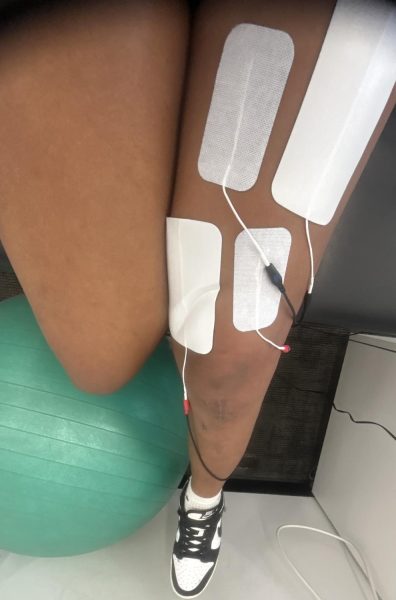Athletic injuries among students are a growing concern; as participation in sports continues to rise, so does the risk of injuries ranging from minor to major impacts. The physical side of recovery usually takes precedence during rehabilitation, while the mental part can often be overlooked. However, addressing both the physical and physiological aspects of injury is crucial for ensuring a full recovery and long-term well-being.
Chloe Armstrong, an eighth-grade soccer player, is still recovering from an ACL injury that she had surgery on nine months ago. She considers the mental aspect to be one of the most crucial components of the recovery process.
“This injury takes a big toll on your mindset because you are just sitting and watching your team from the bench for nine months, and nobody really thinks about the mental side, but it is actually a very important part,” Armstrong said. “I like to set goals for myself, and I feel like that has helped me stay focused and not discouraged.”
As student-athletes face the physical and mental challenges of recovering from an injury. The road to full recovery often requires patience and discipline. For flag football player Kiara Goulbourne, an eighth-grade student at Angeline, staying focused on rehabilitation has been essential in her recovery journey after ACL surgery.
“I have been following my rehab plan focusing on reducing swelling, improving range of motion, and rebuilding strength through physical therapy as well as low-impact exercises,” Goulbourne said. “I am also staying active and maintaining a positive mindset through the process.”

For many athletes, the pressure to return to the field after an injury can be overwhelming. Basketball athlete and seventh-grade student J’Aiden Welch felt like he was letting his team down by not returning quickly.
“I felt a lot of pressure for me coming back because when I got injured we started losing and I’m one of the best players on the team, so we lost our chemistry,” Welch explained.
The recovery process for athletes needs to be an equal balance between eagerness and caution. Strength and conditioning coaches play an important role in guiding athletes through this process, ensuring they don’t rush to play again. Strength and conditioning coach, John Hackworth is proof of this as he explains that while athletes want to get back on the field, part of his job is to keep them from returning too quickly.
“Athletes take it as serious as I do because they want to get back on the field to play as soon as possible, but in some ways, my job is to try to slow them down so they don’t come back too fast due to their enthusiasm to get back on the field,” Hackworth explained.
Coaches work to help athletes stay grounded and focused, especially when the pressure of returning to play can lead to overthinking. Hackworth explains how helping athletes stay present and positive on the field is crucial in keeping their mindset strong.
“Staying positive on the field, keeping their excitement and enthusiasm, and focusing on the here and now are all ways to keep a player from getting in their own head,” Hackworth said. “Just keeping them focused on right now and what’s happening right in front of them.”
While staying mentally present and maintaining a positive mindset are essential for preventing injuries, they are equally vital during the recovery process.
Recovery for student-athletes is a fine balance between physical rehabilitation and mental stamina. The secret to successful recovery lies not only in physical therapy and strength rebuilding but also in maintaining a positive mindset. With the right guidance, athletes can overcome these hurdles and make a strong comeback.
This story was originally published on The Bowman’s Beacon on January 14, 2025.









































